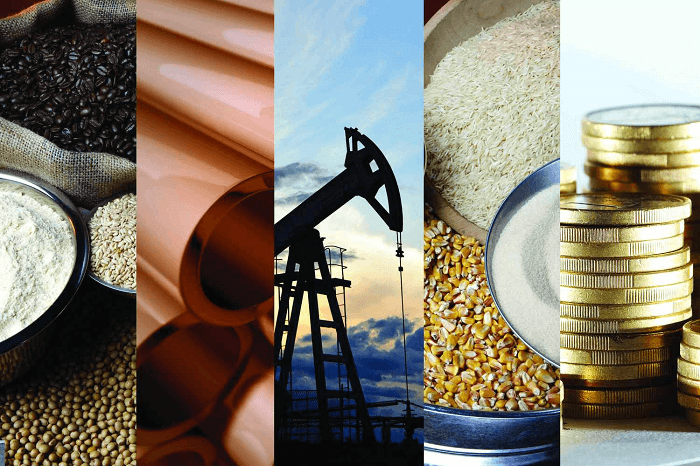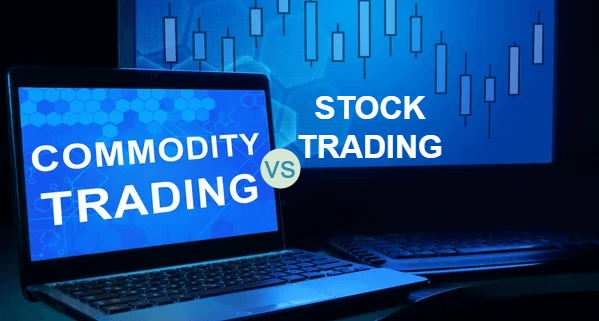Commodity Market: Definition, Types, Example, and How It WorksWhat exactly is a Commodity Market?A commodity market is a marketplace where raw materials or primary items can be bought, sold, and traded. Commodities are typically classified as hard commodities or soft commodities. Hard commodities include natural resources such as gold, rubber, and oil. On the other hand, soft commodities are agricultural goods or livestock like maize, wheat, coffee, sugar, soybeans, and pork. 
How do Commodity Markets function?Commodity markets give producers and consumers access to commodities in a regulated and liquid environment. Market participants can also use commodity derivatives to hedge future demand or output. These marketplaces are also frequented by speculators, investors, and arbitrageurs, making them crucial for such markets. Certain commodities like precious metals are regarded as good inflation hedges. Diversifying a portfolio with various commodities as an alternative asset class might be beneficial. Because commodity prices swing opposite to stock prices, some investors rely on commodities amid market volatility. Commodities trading used to involve a lot of time, money, and knowledge, and it was primarily reserved for professional traders. There are now additional options to participate in commodity markets easily. Buyers and sellers in spot marketplaces exchange cash for quick delivery of the actual commodity. Buyers and sellers in derivatives markets trade money for the right to future product delivery. Derivatives investors frequently roll over or close down their holdings before delivery may occur. Forwards are tailored between counterparties and traded over the counter. Futures and options are exchange-traded products with highly standardized and regulated contracts. HistoryIt dates back to the earliest days of human civilization when tribal bands and newly established kingdoms bartered and traded for food, resources, and other goods. Commodities trade predates stock and bond trading by millennia. The rapid expansion of empires such as ancient Greece and Rome can be directly attributed to their capacity to construct complex economic networks and foster commodities commerce across enormous territories via routes such as the famous Silk Road, which linked Europe to the Far East. Commodities are still widely traded all over the world today. Since the establishment of exchanges and derivatives markets, things have somewhat become more challenging. Commodity exchanges govern and standardize commodity trading, resulting in more liquid and efficient markets. The Chicago Board of Trade (CBOT), set in place in 1848, is the world's most important commodities exchange. It started trading only agricultural commodities like wheat, corn, and soybeans to help farmers and commodity customers manage risk by removing pricing uncertainty from specific agricultural items. It now provides options and futures contracts on various commodities, including gold, silver, US Treasury bonds, and energy. In 2007, the Chicago Mercantile Exchange (CME) Group combined with the Chicago Board of Trade (CBOT), adding interest rates and stock index items to the group's current agricultural commodity offerings. Several commodity exchanges have merged or gone out of operation in recent years. Although most trades carry a few distinct commodities, some specialize in a specific group. In the mid-2000s, the Chicago Mercantile Exchange (CME) bought three other commodities exchanges in the United States. In 2007, CME purchased the Chicago Board of Trade (CBOT), followed by the New York Mercantile Exchange (NYMEX) and Commodity Exchange, Inc. (COMEX) in 2008. All four exchanges comprise the CME Group. In 2007, the New York Board of Trade and the Intercontinental Exchange (ICE) amalgamated to become ICE Futures US. Each exchange provides a variety of worldwide benchmarks for all main asset classes. Commodity Market TypesCommodities are typically traded on spot markets or in derivatives markets. Spot markets, often known as "physical marketplaces" or "cash markets," are where genuine products are exchanged for rapid delivery. Forwards, futures and options are all part of the derivatives market. Forwards and futures are derivatives transactions in which the underlying asset is the spot market. The owner acquires control of the underlying at some point in the future in exchange for a specified price as of today. Physical delivery of the commodity or other things would occur only after the contracts expired. Traders routinely roll over or close out their contracts to avoid having to make or take delivery. In many aspects, forwards and futures are comparable. Forwards are less customizable and are sold over the counter (OTC), whereas futures are standardized and traded on exchanges. What are some commodity market examples?The majority of commodities are exchanged electronically. However, many markets in the United States continue to use the open outcry method. The over-the-counter (OTC) market refers to commodity trading that occurs outside the operation of exchanges. Here are some examples of world-renowned commodity market exchanges that people may be familiar with:
Regulation of the Commodity MarketIn the United States, commodities futures and options markets are governed by the Commodity Futures Trading Commission (CFTC). The CFTC aims to foster competitive, efficient, and transparent markets that safeguard consumers from fraudulent and unethical behaviour. The CFTC and its related rules were established by regulating commodity exchange activities to prevent and remove impediments to interstate commodity commerce. Regulations, for example, strive to restrict or discourage short selling while removing the possibility of market and price manipulation, such as market cornering. Since its inception, the Act that formed the CFTC has been amended multiple times, most recently in the aftermath of the 2007-2008 financial crisis. Because of the Dodd-Frank Wall Street Reform and Consumer Protection Act, the CFTC now has power over the formerly unregulated swaps market. Commodity market regulation has remained in the limelight since the CFTC and the US Department of Justice arrested eleven large investment banks in 2015 as part of a worldwide precious metals manipulation investigation. Commodity Trading versus Stock Trading
Access to commodities markets, spot or derivatives, is too expensive for most private investors. Direct access to these markets is frequently required through a specialized brokerage account and/or necessary permissions. Because commodities are seen as an alternative asset class, commodity trading funds, or CTAs, typically allow only accredited investors. Nonetheless, regular investors might acquire indirect access to commodities through the stock market. Stocks in mining or materials industries are often associated with commodity prices, and there is currently a variety of ETFs that track specific commodities or commodities indexes. These ETFs can help investors diversify their portfolios. Still, for most long-term investors, stocks and bonds will be the foundation of their holdings. Furthermore, commodity prices are more volatile than equities and bonds, so commodity trading is frequently best suited for people with more risk tolerance and/or a longer time horizon. Are they a good investment?Commodities, like any other investment, may be profitable but also risky. An investor must comprehend the products of the markets they desire to trade in, such as the understanding that oil prices might change due to the Middle East's political situation. The investment style also matters; ETFs offer more diversification and fewer risks, but futures are more speculative and carry higher risks due to margin requirements. Having said that, commodities are viewed as a hedge against inflation, with gold, particularly; they are more like a hedge against a market slump. How to know about the current prices of the commodity markets?Many internet financial platforms will give you an idea of the price of commodities like gold and crude oil. Prices are also available on commodities exchange websites. What exactly are commodity traders?Commodity traders purchase and sell actual (spot) commodities as well as derivatives contracts that employ a physical commodity as the basis. Depending on your trading style, you may utilize this market for various goals, such as purchasing or selling a genuine product, hedging, speculating, or arbitraging. What are some notable illustrations of the commodity?There are a variety of goods accessible. Crude oil, natural gas, and gasoline are examples of energy products. Precious metals include gold, silver, and platinum. Wheat, corn, soybeans, and animals are examples of agricultural products. Coffee, sugar, cotton, and frozen orange juice are just a few of the other items one can exchange. The Bottom LineCommodity markets are critical to the global economy. As a result, it is vital to understand how commodity prices are created, both spot and futures, and whether there are any pricing distortions. Understanding what drives market patterns is critical for an investor and establishing policy frameworks that support economic goals such as long-term growth, inflation stability, poverty reduction, food security, and climate change mitigation. Policy frameworks that enable countercyclical macroeconomic responses are becoming more common and beneficial. Other instruments of policy have had varying degrees of success.
Next TopicCottage Industry
|
 For Videos Join Our Youtube Channel: Join Now
For Videos Join Our Youtube Channel: Join Now
Feedback
- Send your Feedback to [email protected]
Help Others, Please Share









